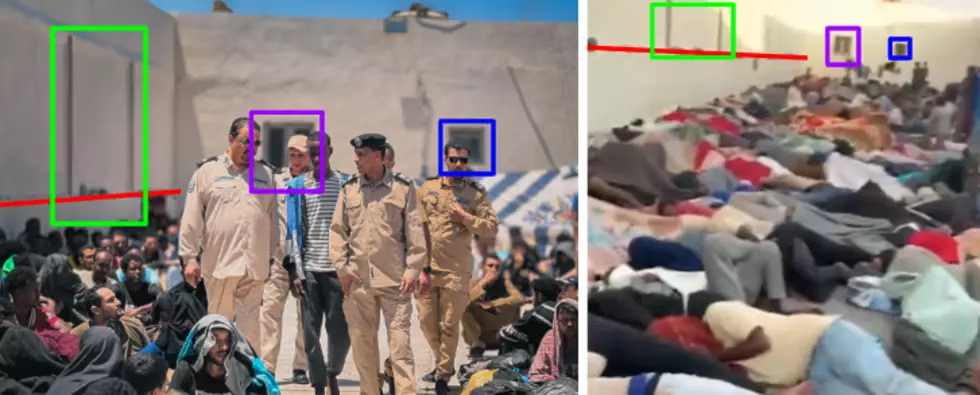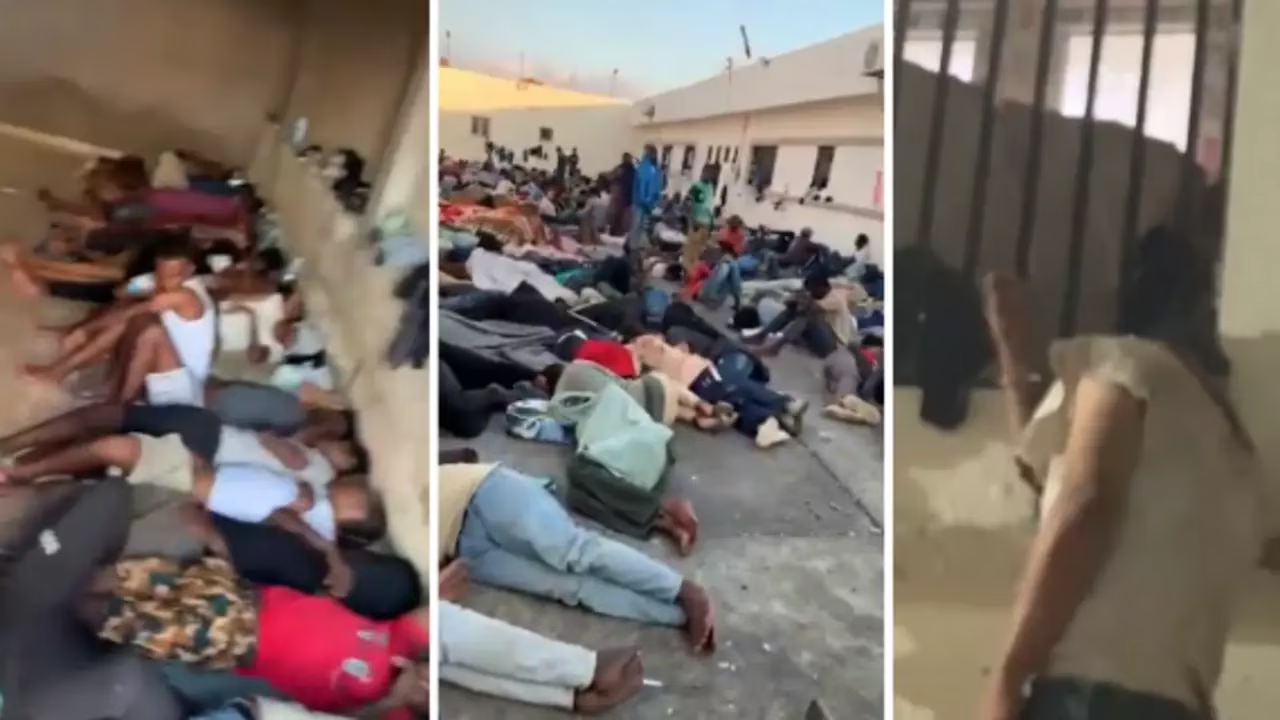In early September, the NGO Refugees in Libya posted videos on social media showing dozens of refugees sitting on the floor of an overcrowded detention center in Tobruk. According to our observer, who was once imprisoned there himself, the footage is yet another testament to the violence faced by those seeking asylum in Libya.
A video posted on September 1, 2025, on X shows dozens of refugees lying directly on the ground without mattresses or blankets.
Two videos released by the humanitarian group Refugees in Libya expose the appalling conditions in which migrants are held in Libyan detention centers. The first, posted on September 1, shows dozens crammed into a single cell. They lie directly on the floor, without mattresses, blankets or even shoes. According to the organization, more than 900 people were being held at the site; the footage shows at least a hundred.
The second recording, posted ten days later, showed a man handcuffed to the bars of a window. The footage was provided by people held inside the detention center in Tobruk, in northeastern Libya. The area is under the control of the government backed by the House of Representatives in Tobruk and the Libyan National Army of Field Marshal Khalifa Haftar.

Photos show the migrant detention center in Tobruk, northeastern Libya.
A photo published on August 3 on Facebook by the "Libyan Anti-Illegal Migration Agency," which manages the center, shows the same courtyard. The post was tied to a meeting aimed at "combating illegal migration, smuggling and all forms of criminal activity." The caption read: "📍Tobruk | Al-Butnan Center." In the image, the same two windows at the far end of the yard where refugees sleep are clearly visible, as is the wall on the left with its distinctive two vertical lines.
Omar (name changed) is from Sudan. He was held in the Tobruk detention center but managed to secure his release by paying guards a large sum. Earlier this year, he left Sudan hoping to reach Europe, but in the spring he was detained in Libya. Many migrants and refugees choose this route in their attempt to reach the European Union, especially after Tunisia tightened measures to prevent crossings of the maritime border with the EU.
"I was detained on the street in Libya along with other people. I was trying to reach relatives in another city but ran into the police and ended up in Tobruk. The prison holds people of many nationalities. We all want to get to Europe, but first we must pass through Libya."
He said guards demanded enormous sums from refugees in exchange for release. In practice, this meant that detainees’ families had to step in and pay ransom.
"If you are from Sudan, they ask 2,500 Libyan dinars (about €392) to get out of prison. But people of other nationalities are charged even more. For example, if someone is from Chad, Egypt, Ethiopia, Yemen, Syria, Pakistan, Bangladesh, South Sudan or Somalia, the amount is 7,000 Libyan dinars" (about €1,100).
Omar said he spent several months in the center.
"This is a very large prison. There were hundreds of us there. There wasn’t enough food or water. The problems inside were overwhelming.
At night we were locked in a room without ventilation, where the heat was suffocating. There was no oxygen. In the morning, when we were let outside, the air was cold. Catching a cold, the flu or a fever was all too easy.
At night it was strictly forbidden to speak. We were released from the cell around ten in the morning, and only then could we exchange words about what was happening inside.
Diseases were everywhere in the prison: scabies, pox, rashes, high fevers—everything. To be honest, the conditions were extremely harsh."
At night we were locked in a room without ventilation, where the heat was suffocating. There was no oxygen. In the morning, when we were let outside, the air was cold. Catching a cold, the flu or a fever was all too easy.
At night it was strictly forbidden to speak. We were released from the cell around ten in the morning, and only then could we exchange words about what was happening inside.
Diseases were everywhere in the prison: scabies, pox, rashes, high fevers—everything. To be honest, the conditions were extremely harsh."
The NGO Refugees in Libya regularly publishes photos and reports on the situation of refugees in the country. According to its representatives, they receive dozens of messages every day, and the number of detainees in this center continues to grow.
The second video shows an instance of brutal treatment: the footage captures a severely weakened man handcuffed to the bars of a window, forced to stand without being able to sit.
A video posted on September 11, 2025, on X shows a man handcuffed to the bars of a window in the Tobruk migrant detention center.
Omar said he learned about this man from friends who are still inside the detention center.
"They grabbed him right off the street. They took his iPhone to hack it through iCloud. But he refused to unlock the phone. After that they beat him and tortured him. Then they sent him to solitary confinement. He was tortured especially cruelly—they were determined to get into the phone, so they kept beating him again and again.
Then they handcuffed him to the bars of a door window. He was afraid. He had to stand all night. In the morning they beat him again and sent him back to solitary confinement. The abuse continued every day to force him to open iCloud.
They wanted that phone specifically because it was expensive. Such an iPhone costs about 6,000–7,000 Libyan dinars (€940–1,100), so they take it by force.
A Samsung, which costs 400–600 dinars (€60–100), they don’t care about. They only hunt for expensive things."
Then they handcuffed him to the bars of a door window. He was afraid. He had to stand all night. In the morning they beat him again and sent him back to solitary confinement. The abuse continued every day to force him to open iCloud.
They wanted that phone specifically because it was expensive. Such an iPhone costs about 6,000–7,000 Libyan dinars (€940–1,100), so they take it by force.
A Samsung, which costs 400–600 dinars (€60–100), they don’t care about. They only hunt for expensive things."
Although this particular episode of abuse was captured on video, Omar stresses that such cases are far from isolated. According to him, torture and mistreatment have become part of daily life for migrants in the detention center.
"In the prison there is a place where soldiers beat people. They hit with iron, they hit with anything at hand. Sometimes you are just standing in line for bread or water, where it is very crowded. But if someone steps out of line, they are beaten immediately. Those who refuse to go back into the rooms are punished as well. And beyond that, they try to squeeze any money out of us that we might have."
Like those held in Tobruk, thousands of migrants across Libya are confined in inhumane conditions. The practice of extorting money for release has existed for many years. In 2023, Médecins Sans Frontières called for the creation of humanitarian corridors for asylum seekers.
Since the fall of Muammar Gaddafi’s regime in 2011, the country has been trapped in a spiral of violence and instability. Today Libya is divided between two centers of power: in the west, the UN-recognized Government of National Unity, and in the east, the House of Representatives and forces loyal to Marshal Haftar.
